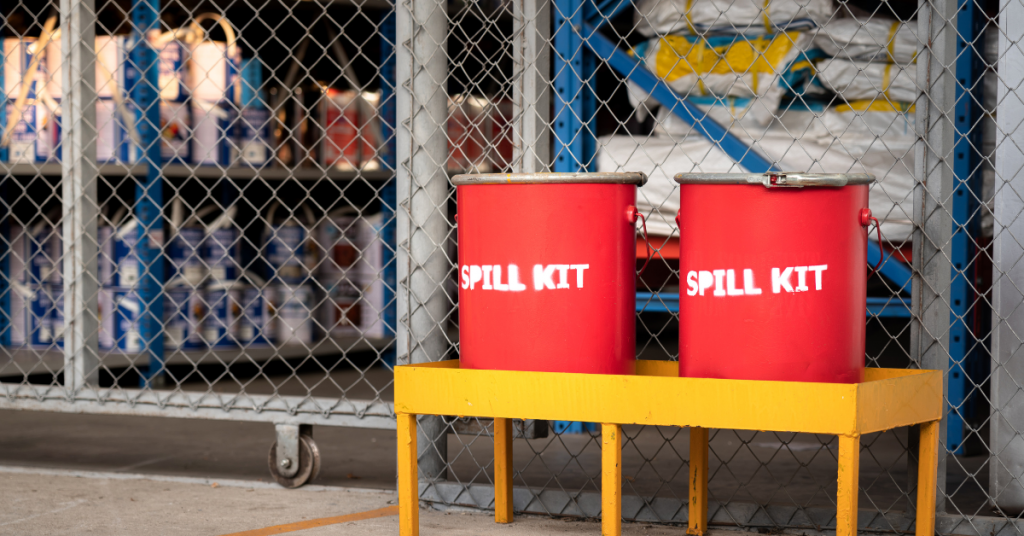In any workplace where liquids are handled, spills can happen at any time. Whether it’s a warehouse, workshop, laboratory, or petrol station, the risk is always there. Quick response makes all the difference between a small mess and a bigger hazard. That’s why having a proper spill kit on site is not just helpful, it’s necessary.
These kits are used to clean up oils, chemicals, fuel, and water-based liquids. They come with tools and materials that are designed to contain and absorb the spill safely. The goal is to clean up fast, reduce risk to workers, and prevent damage to the surroundings.

What’s Inside a Spill Kit?
Every kit is a little different depending on what it’s meant to clean up, but most include some standard items. These often include absorbent pads, rolls, socks, and disposal bags. Some kits include safety gloves, goggles, and even floor signs to warn others while the area is being cleaned.
The type of spill matters. A general spill kit is good for water-based liquids and mild chemicals. Oil-only kits are made for petrol, diesel, and motor oils. Chemical kits are used where stronger or more dangerous liquids are kept. Knowing the right type for your work site is step one.
Why You Shouldn’t Delay Cleanup
Leaving a spill untreated doesn’t just cause mess. It leads to real safety problems. Slippery floors can cause injury. Chemical spills can burn skin or release fumes. Even small spills can spread fast, especially on smooth flooring. Quick use of a spillage kit helps stop the problem before it spreads.
Spilled fuel near machines or open flames is a fire risk. Leaked oil in a cold room could freeze and create a hazard. Even food warehouses need to control spills to avoid contamination or insect problems. In each case, response time matters.
Training Matters Too
It’s not enough to have the kit. Staff should know how to use it. A well-stocked kit is no help if nobody knows what to do with it. Simple training sessions can help workers understand how to use each item in the kit, where it’s kept, and when to act.
Part of this includes knowing when it’s safe to clean a spill, and when to get help. Not every spill is safe to clean without gear. A chemical leak may need proper ventilation or a mask. Training helps avoid panic and confusion.
Where to Keep the Kits
Placement matters. A kit stuck in a locked office won’t help much during a shift in the workshop. Kits should be placed where spills are likely, near loading zones, fuel tanks, machinery, or chemical storage rooms. Even break rooms or bathrooms can benefit from smaller spill kits.
In large buildings, more than one kit may be needed. Spreading them out across floors or departments saves time when it counts. It also makes it more likely that someone will use the kit quickly.
When to Replace a Spill Kit
Used kits should be restocked right away. Every time a spill is cleaned, the used pads and tools need to be replaced. Without a proper system, the kit can sit empty for weeks until another spill occurs, and by then it’s too late.
Set reminders to check the kit weekly or monthly. Some businesses assign the task to a supervisor or cleaner. Others include it in their safety inspection list. Either way, it only takes a minute to check that all the parts are there.
Not Just for Large Businesses
Even small shops, garages, and mobile service units can benefit from having a spillage kit on hand. Whether it’s a bottle of cleaning fluid knocked off a shelf or an oil can leaking in a delivery van, it’s good to be prepared.
Spills happen fast, but cleanup should happen faster. Having the kit nearby shows care for the people using the space, and helps avoid lost time and damage later.
Final Thoughts
A single spill may not seem like much at first. But without the right gear, it can lead to accidents, injuries, or costly damage. That’s why every site that handles fuel, oil, paint, chemicals, or even cleaning products should have a proper spill kit ready. Whether you manage a warehouse, small shop, or service vehicle, don’t wait until the mess is too big to control.